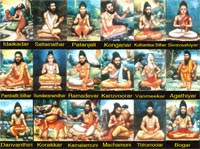We have got many Siththars poems which concealed information regarding the process of transferring soul between bodies. As far as, we consider the process of transferring a soul from live body to lifeless body is called ‘koodu vittu koodu paaithal’ in Tamil. Even of getting into new body, the souls has good memory about the past body’s information and also do the unfulfilled remained duties of newer body.
Korakkar saw a shepherd’s body near his cave that was dead due to snake’s biting. On seeing the sorrows of shepherd’s wife, Korakkar himself transferred his own soul into that shepherd’s body, thereby to eradicate the sorrow of her. Above information can be seen in the following poem:
கண்டதோ ரிடையன் றன்னைக் கதித்ததோர் நாகந்தீண்டி
kanda thoaridaiyan trannaik kathiththathoar naakantheendi
கொண்டதோ ரிடையன் சாகக் குறித்திடுந் தோழர்கண்டு
kondathoa ridaiyan saakak kuriththidun thoazharkandu
விண்டவன் மனையாளுக்கு வேகமாய்ச் சென்று சொல்லப்
vindavan manaiyaalukku vaegamaaich senru sollap
பண்டுள்ள விதியோ நான்தான் பாவியோ யென்றுவந்தாள்
pandulla vithiyoa naanthaan paaviyoa yenruvanthaal
வந்தவள் துயர்கண்டு மறுகூடு பாய் வதற்கு
vanthaval thuyarkandu marukoodu paai vatharku
அந்தமா கிரிக்குச் சென்று ஆக்கையைப் பதனஞ் செய்து
anthamaa kirikkuch senru aakkaiyaip pathananj seithu
நந்தனா மிடையன் கூட்டில் நயமுடன் பாய்ந்து பின்பு
nanthanaa midaiyan koottil nayamudan paainthu pinbu
முந்தியுள் ளிடையன் போல மங்கைமுன் வந்தார்
munthiyul lidaiyan poala mangaimun vanthaar.
One day, a king came to forest for hunting sees the Korakkar’s original body and thinks as it as some dead body. Hence he burnt that body in fire after sometime. Korakkar in shepherd’s body came into forest in search of his own body and found it missing. Therefore, he summoned his disciples Nagarjuna and Chanakya and then three of them visited many forest to see other Siththars. He stayed a year in each Siththar’s place and had enough kalpa. Then he lived a long life with that shepherd’s body.
Sattainathar was born on Kaasi in Saeniyar tribe got enlightenment and wisdom. On having kalpa, he travelled many places and then reached Sathuragiri, where he found a body of Brahmin. He then transferring his soul in that Brahmin’s body had many more kalpas and lived. This can be inferred from the following poem.
பெற்றுடன் வாழ்ந்தா ரந்தப் பேர்பெற்ற சட்டைநாதர்
petrudan vaazhnthaa ranhthap paerpetra sattainaathar
உற்றசேணியர் குலத்தி லுதித்துநெய் தொழிற் படித்து
utrasaeniyar kulaththi luthiththunei thozhir padiththu
நற்றமிழ் தேர்ந்து இந்த நானில மெய்க்க ஞானங்
natramizh thaernthu intha naanila meikka gnanang
கற்றுமே கற்பங் கொண்டு காசினி தனைவிட் டேகி
katramae karpang kondu kaasini thanaivit taeki
விட்டுடன் மலையி லேறி வேதைக ளநேகஞ் செய்து
vittudan malaiyi laeri vaethaika lanaekanj seythu
சட்டம தாக வேதான் சதுரமா கிரியில் வந்து
sattama thaaka vaethaan sathuramaa kiriyil vanthu
மட்டுடன் பிராமண தேக மதனிலே நுழைந் துகந்து
mattudan piraamana thaeka mathnilae nuzhain thukanthu
திட்டமாய் கற்பங் கொண்டு சிறப்புட னிருந்தார் பாரே
thittamai karpang kondu sirappuda nirunthaar paarae.
Konganavar who was born on shepherd’s tribe naturally lived by eating kalpa and been in good relationship with Palingar tribes. On that occasion, the leader of Palingar got died. On seeing the people’s sorrow, Siththar Konganavar himself got into that leader’s body. People overwhelmed in joy burnt Konganavar’s body. After that, he searched medicinal plants and climbers with help of Palingars then he prepared kalpa and lived a long life.
உள்ள கொங் கணரு மாதி யிடையனா யுலகந் தன்னில்
ulla Kon ganaru maathi yidaiyanaa yulakan thannil
மெள்ளவே கற்ப முண்டு வியப்பதாய் மலையில் வந்து
mellavae karpa mundu viyappathaai malaiyil vanthu
வள்ளலா யிருந்து பேரை வாங்கியே பளிங்க ரோடு
vallalaa yirunthu paerai vaangiyae palinga roadu
கள்ளமில் லாமல் வாழ்ந்து காட்டினி லிருந்து வந்தார்
kallamil laamal vaazhnthu kaattini lirunthu vanthaar.
வந்திடும் போதங் கேதான் மலைப்பளிங் கணுமே செத்து
vanthidum poathang kaethaan malaippaling kanumae seththu
விந்தையாய்ப் போகப் பார்த்து மிகவேதா னிரக்கங் கொண்டு
vinthaiyaaip poakap paarththu mikavaethaa nirakkang kondu
சந்தோஷ மாகத் தம்தன் சரீரத்தை வைத்து விட்டு
santhoasha maakath thamthan sareeraththai vaiththu vittu
இந்தநல் சரீரந் தன்னி லியல்புடன் பாய்ந்து விட்டார்
inthanal sariiran thanni liyalpudan paainthu vittaar.
விட்டதைப் பளிங்கர் கண்டு மிகவேகொங் கணர்தேகத்தை
vittathaip palingar kandu mikavaeKong kanarthaekaththai
கட்டையில் வேகவைத்துக் களிப்புட னிருந்து விட்டார்
kattaiyil vaekavaiththuk kalippuda nirunthu vittaar
திட்டமாய்ப் பளிங்கரோடு சேர்ந்திலை செடிகள் கண்டு
thittamaaip palingaroadu saernthilai sedikal kandu
சட்டமாய்த் தெரிந்து கற்பந் தானுண்டு மலையில் வாழ்ந்தார்
sattamaaith therinthu karpan thaanundu malaiyil vaazhnthaar
மலையிலே வாசஞ் செய்து வந்தன ரங்கங் கேதான்
malaiyil vaasanj seithu vanthana rangang kaethaan
தொலைதனி லிருக்கும் பூடு துறவுடன் தெரிந்து கொண்டு
tholaithani lirukkum poodu thuravudan therinthu kondu
வலையினி லகப்படாமல் மலையெலாஞ் சுத்திச் சுத்தி
valaiyini lakappadaamal malaiyelaanj suththich suththi
இலைசெடி மரங்கள் தானும் இயல்புட னறிந்திருந்தார்
ilaisedi marangal thaanum iyalpuda narinhthirunthaar.
Similarly, we have much information regarding this soul transferring techniques of Siththars. Each of these poems has its background which told the humanity of those great people. As of now, research and further clarification can only be done by me. After collecting the information about this in series, then only it might be a starting point concerning this topic. Further discussion and research can be done if I get Guru’s gracious blessings in future.
Original – www.siththarkal.com
Translated by Lalithambika Rajasekaran

